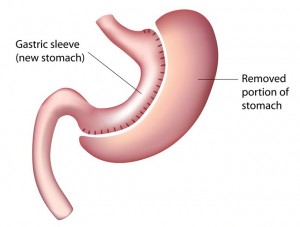 Also known as a Gastric Sleeve Procedure, Sleeve Gastrectomy involves removing around 80% of the stomach and leaving behind a thin, banana-shaped sleeve that can hold approximately 50 to 100mL of fluid.
Also known as a Gastric Sleeve Procedure, Sleeve Gastrectomy involves removing around 80% of the stomach and leaving behind a thin, banana-shaped sleeve that can hold approximately 50 to 100mL of fluid.
The new stomach is around one quarter of the size of the previous stomach, which restricts the amount of food a person can eat. In addition, the surgery removes some of the cells in the stomach that make ghrelin, a hormone that controls hunger. Patients who have this surgery often find they do not feel as hungry as they did previously and feel full more quickly when they do eat, which reduces their food intake. For patients who have diabetes, this can improve and even resolve the illness, with patients no longer needing to take anti-diabetic medication.
Unlike Gastric Bypass, where the food is passed into a small portion of the stomach and then directly into the small intestine, after Sleeve Gastrectomy, food passes along the usual route, rather than bypassing the digestive tract. Food is therefore still absorbed and patients are less likely to need vitamin supplements.
The procedure is usually performed using keyhole surgery, with the patient under anesthetic. It takes between two to four hours and the hospital stay is two days. Gastrectomy is not reversible.

